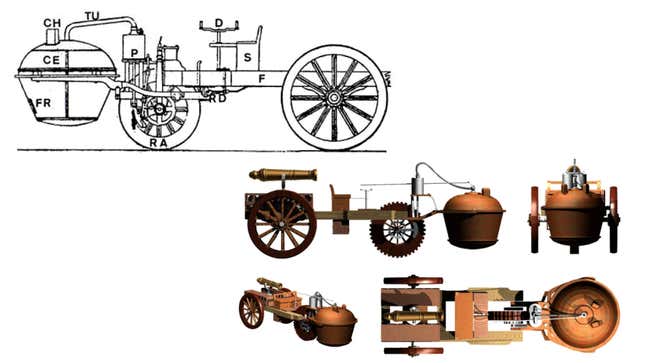
Mercedes-Benz is a company with a rich, long history and plenty of impressive achievements to crow about. They’re still one of the most respected carmakers today, one of the oldest still-extant automotive brands in the world. That’s why I’m always disappointed to see them trotting out the claim that they made “the first automobile,” which simply isn’t true. Now they’re celebrating what they claim is the “very first motorized truck in the world,” which also isn’t true. Let’s look into this.
Daimler, Mercedes-Benz’ parent company, put out a press release titled “Right on time for the 125th anniversary of the truck: 275 years of truck history on the way to England” where they’re talking about sending a pair of replicas of historic Daimler-Benz trucks to the UK. The press release starts with this sentence:
On 18 August 1896 Gottlieb Daimler presented the very first motorised truck in the world.
That’s a really bold claim, considering there have been vehicles that could qualify as a “motorised truck” for 127 years before these Diamler machines.
That’s not to say the Daimler trucks from 1896 and 1898 aren’t significant—they absolutely are, and deserve a revered place in motoring history. They just don’t deserve the mantle of “first truck,” which really demands a much more involved answer.
If we’re describing a “motorized truck” as a self-propelled, road-based vehicle with some sort of engine and designed to haul things, then I don’t see any reason why we can’t peg the first truck to the very first real automobile ever, the 1769 Cugnot Steam Drag.
Part of the reason the first automobile in the world was such a strange, clunky, difficult-to-drive machine was that it was designed with a very specific purpose in mind: to haul artillery.

If you look at the design of the Cugnot machine, the strange placement of the massive boiler ahead of the front wheel (which was the drive and only steerable wheel) makes sense only if you realize that the rear was designed to hold heavy guns and cannonballs. It was a flatbed truck!

That’s why, unburdened with cargo, it was such an understeering disaster that crashed into a wall. It wanted to be hauling stuff. Like a truck.
If Daimler doesn’t want to count this because it’s a one-off, well, fine. If we’re willing to consider trucks to be motorized vehicles designed to haul things on roads—which I think is an entirely reasonable definition of a truck, then the Thomson Road Steamers, built from 1869, would certainly qualify, and these were built in some quantity and sold to customers in many countries.

These were steam-powered hauling vehicles, and they would move their cargo by pulling it in a separate trailer or wagon. In some cases, many, creating what would be, effectively, a road train:

Thomson Road Steamers were the mid-1800s equivalent of a big rig, like the Mercedes-Benz Actros being used to haul their two replicas to the UK. For the record, Mercedes-Benz calls the Actros a truck.
Maybe Daimler will insist that, to qualify, a truck has to be all one unit, and must have an internal-combustion engine. If they did insist such things, I’d think that was silly, but I’d also point to Jean Joseph Étienne Lenoir’s 1863 vehicle, the Hippomobile.

Lenoir’s Hippomobile used a one-cylinder, hydrogen-fueled, spark-ignited internal combustion engine that, while it didn’t use the Otto cycle that came to dominate combustion engines for over a century, nevertheless worked well enough for Lenoir to sell stationary versions of the engine commercially, and to power this open-topped, wooden-bodied pickup truck.
The Hippomobile was recorded as making at least one six-mile journey around Paris, and some reports suggest multiple ones were built, but I haven’t been able to confirm that to my satisfaction.
Still, this is absolutely a motorized, truck-like vehicle, from 33 years prior to the Diamler truck.
If we want to look at other successful truck-like vehicles, any of the steam omnibuses used in the UK during their boom in the 1820s and 1830s really should qualify. These vehicles were made by a number of builders including Goldsworthy Gurney and Richard Trevithick and Walter Hancock, and tended to be large, van-like vehicles with seats in them to transport passengers and their cargo.

If you took out the seats, they’d be trucks. They’re motorized, drivable boxes on wheels, like a U-Haul truck you could go-out and rent today. Maybe Daimler can disqualify them because of the seats and their primary usage (though I’m pretty certain they ended up hauling more than just passengers), but at this point we’re getting a bit into semantics.
Daimler’s 1896 and 1898 trucks are absolutely significant. They are definitely some of the first trucks of their kind and were among the earliest practical, commercial otto-cycle trucks, made initially from a converted horse-drawn wagon and fitted with Daimler’s four horsepower, two-cylinder engine at the rear, under the bed, much like the Hippomobile.
But I don’t think Daimler can honestly make the claim that
The first truck in the world was built by Gottlieb Daimler in 1896
...as they do, multiple times. It’s just not true, and continuing to claim this only confuses the true, rich, complicated history of the automobile and degrades Daimler’s many, many genuine claims to automotive history.
So, come on, Daimler. You don’t need to do this.